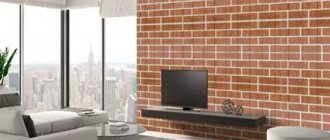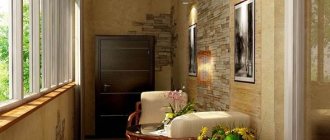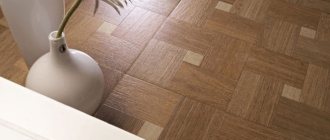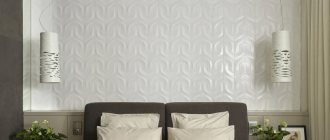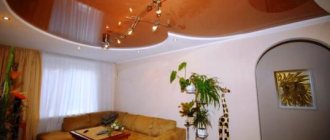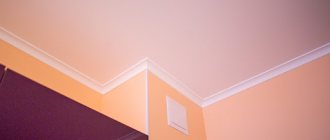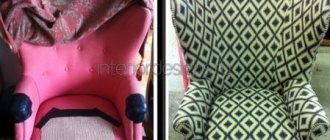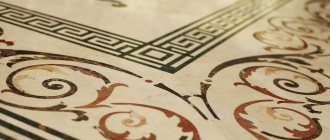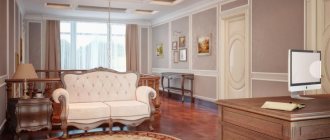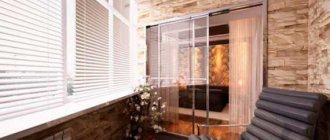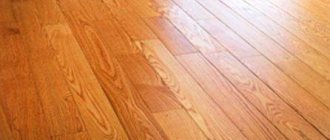Characteristics of natural stones
The facing stone is chosen from many varieties of natural materials. At the same time, the texture reflects the elegance, style and nobility of the structures being built.
To have an idea of the variety of natural materials, let's get acquainted with the most popular options.
Marble
The most common type of cladding. Marble has a rich palette of shades of white, red, gray, pink, green, brown and black. Stone patterns are created by its structure and depend on the methods of sawing the rock. The unique pattern of marble is used to create picturesque compositions.
Marble is characterized by many inclusions of different shades with veins and stripes. Processing methods affect the surface texture of the material: smooth, glossy or aged.
Cladding a fireplace with marble can be used in combination with other building materials. An excellent option based on marble stone, while maintaining high natural quality, is the use of ground marble.
Almost all varieties of rock are crushed into various fractions, which are used to produce marble mosaics or the main filler. Most often, monochromatic varieties of white and black marble are used.
Granite
It is one of the most durable, massive and durable types of materials. Finishing the fireplace with natural granite ensures the reliability and attractiveness of the structure. The natural texture fits harmoniously into the design of the space, containing matching granite objects, such as furniture or railings.
Granite material has unique decorative properties. The finish is characterized by bright patterns and uniform grain throughout the entire surface.
The location of extraction affects the variety of colors and its shades. High strength ensures long-term use. History has recorded facts of hundred-year-old granite fireplaces that still heat castles, as well as large mansions.
This stone is easy to process, providing the embodiment of a wide variety of design ideas. The combination of various slabs, mosaics, and collages created when facing the fireplace looks impressive. This design method gives exclusivity to each design element.
The use of granite to decorate a fireplace demonstrates the status of the owner and his attitude to life. Rich people enhanced the impression by using rare colors in order to add not just beauty, but to create originality and uniqueness of the interior.
The most popular types of stone for finishing a stove
Onyx
An expensive option, which at the same time allows you to get a unique visual result. Onyx looks really solid and confirms the high level of its owner. Well, the translucent structure of the mineral allows it to be used in combination with lighting, which makes it possible to create amazing designs. It is necessary to entrust the cladding of a fireplace with onyx exclusively to highly qualified specialists, since not every mason has the relevant experience.
Rubble stone
Natural stone, like the one under our feet. It has no special value, but attracts with its natural component and excellent appearance. Well, the low cost, in turn, is only a plus, as it makes such finishing accessible to many. It can be either natural or artificial. Moreover, the latter can be done with your own hands - by mixing cement, water, sand and pigments, and filling silicone molds created using natural stones with all this.
Important! Self-production of rubble stone based on gypsum is not carried out, since this material can crack under the influence of temperature changes.
Talkomagnesite
The mineral is of volcanic origin and is used for finishing stoves, both in bathhouses and in residential buildings, as well as fireplace structures. The attractive appearance gives solidity to any surface finished in this way. At the same time, the mineral perfectly accumulates heat, releasing it to the environment and warming up the room. The surface itself remains warm and pleasant to the touch.
Advantages of marble and granite for decoration:
- resistance to temperature changes;
- when heated, they do not emit harmful odors and smoke;
- always impressive appearance;
- combination with various building materials, such as wood, metal, glass, ceramics and other natural stones;
- undemanding operation;
- high strength, immunity to external influences.
Soapstone chlorite
Refers to a popular type of finishing materials. Thanks to its layered structure, it provides high heat capacity, so heat is retained in the stone and its surface is always warm.
They have known about it for many centuries. In Ancient Egypt and Asian countries, magical properties were attributed to it. The frequency of the emitted heat matches human radiation. The stone is believed to convey healthy natural strength when in contact with the human body. This strength increases the body's immunity and increases resistance to various bacteria and diseases.
In folk medicine there is information about the beneficial effects on human health, normalization of blood pressure, restoration of the respiratory system and metabolism.
Soapstone has high density, thermal conductivity and low thermal expansion. These qualities are best used when finishing fireplaces and stoves.
Sandstone
It is used for the front decoration of the fireplace, as it is resistant to high temperatures, durable and has a strong structure. Thanks to the uniqueness of this stone, a variety of original solutions for the fireplace are obtained.
It is easy to process and can be cut. It has a large selection of colors, shades and unique appearance. When facing with sandstone, you can create picturesque stone paintings.
This type of material best combines the qualities of decorativeness, environmental friendliness and affordable price.
Granite ceramics
Refers to a kind of finishing material, which is made from natural clay and is used for decorative finishing. The appearance is similar to the texture and color of granite, marble and similar stones.
This material differs from ordinary ceramic tiles only in the basis of its manufacture. Granite ceramics are made using especially durable clay. In other respects they are very similar, especially in appearance.
Thanks to the clay contained in porcelain stoneware, this material has a strong structure, is not subject to mechanical stress, is resistant to elevated temperatures and is durable. During operation, the finishing stone always retains its color and original shine.
Shell rock
It is one of the most unique natural stones that create an original fireplace lining. Thanks to its natural porous structure, it has high thermal insulation and resistance to high temperatures, which is an important factor for finishing a fireplace.
The shell rock contains the remains of fossilized sea shells and mollusks, which are preserved inside the stone.
To create the required shapes from shell rock, it is polished.
The most common yellow and white colors with various shades are successfully used for interior decoration. Cutting out original parts from sandstone-shell rock allows you to design the structure in accordance with any requests of the owners.
Cladding with natural stone is not always suitable for decorating fireplaces. Modern technologies make it possible to use materials that are superior to natural stones in terms of heat transfer.
Therefore, use stone to decorate fireplaces if you are satisfied with the low heat capacity of its surface.
It is important to know that:
- stone finishing reduces the efficiency of the structure, absorbing heat;
- facing the fireplace with granite can be done in the house if it is not the heat transfer that is important, but the presence of a live fire;
- the durability of marble and granite fireplaces is an indisputable fact.
If you use the softest of stones - limestone, then only after a few decades you will be able to see the destruction of its structure. Other stones are less susceptible to external influences, so finishing with natural materials does not have an expiration date.
Stones and minerals
Most natural stones have the necessary properties for finishing stoves. The only things that vary are the degree of their strength and heat resistance, the texture of each type, the presence of deposits, methods of extraction - their cost ultimately depends on these factors. Finishing a fireplace with stone should be carried out not only based on the financial capabilities of the customer, but also taking into account the specific properties of the material.
Rubble stone
The most common and affordable is rubble stone, which can have torn or slab-like shapes. The definition of “rubble stone” means pieces of limestone, dolomite or sandstone. So:
- Bite is obtained by mining local rocks: both erupted and sedimentary. Rubble stone is processed into crushed stone and used in the construction of buildings and technical structures - its strength coefficient allows this.
Natural rubble stone in the decoration of the fireplace
- Decorative finishing of stoves with stone is most often made from rubble stone, both natural and artificial. This type of masonry is perhaps the most ancient. After all, this is, as they say, a stepping stone that does not have much value. And any surface decorated with it looks very good.
Natural rubble stone
- Natural stone is quite heavy; certain costs will be required not only for its purchase, but also for delivery. And not every structure can support its weight. Making imitation rubble stone is a good alternative, given the fact that you can do it yourself and at home.
- For this you need a few stones for a sample, silicone, and ingredients for mixing the solution: cement, sand, pigments. You can even purchase ready-made dry mixture, sold in 25 kg bags. It is enough to mix it with water, as prescribed by the manufacturer’s instructions, and the solution is ready.
- The main thing is that the composition for such production is based on cement as a binder. The fireplace is not finished with artificial stone based on gypsum. Gypsum does not have the necessary properties for this, and can crack when heated and cooled.
- The production of stone begins with the selection of a container that will serve as formwork. This can be a plastic, metal or wooden box in which you can place one large or several small stones. You can make several molds at once if you need to make many copies.
- The samples are lubricated with any lubricant, possibly lithol or grease, after which liquid silicone, which is sold in bottles and canisters, is poured into the formwork. The silicone is compacted using a regular paint brush, and its surface is leveled with a spatula. Tools must be moistened with soapy water or any dishwashing detergent.
Solution poured into silicone mold
- The silicone takes up to three weeks to dry, after which the mold is ready for use. The mixture for making stone is poured into it, up to about half, and compacted by shaking and tapping.
- To give the stone additional strength, pieces of reinforcing mesh are placed on top of the mortar, after which the rest of the mortar is poured. You don’t have to add dye to the second layer, it will be more economical.
- When the mold is completely filled, a relief is created on the surface of the solution, which is necessary for good adhesion to the surface of the oven when facing. For this purpose, you can use any sharp object - a nail, a stick, a comb, or a spatula with teeth. The finished stone is removed from the mold after 12 hours, but it will take another two weeks to gain strength.
This simple method is used not only for the production of artificial stone, but also all kinds of stucco elements, baguettes, tiles and gypsum panels. If you are interested in this topic and want to make the artificial stone for finishing the fireplace yourself, we recommend that you first watch the video.
Onyx
Stone finishing of fireplaces is often done using more expensive, semi-precious rocks. This category includes a very beautiful natural stone called onyx. Finishing any interior details with onyx is suitable for those who want real exclusivity:
- Many natural stones have not only wonderful aesthetic, but also healing properties. That is why they are so attractive to humans, including onyx.
Onyx texture
- This stone has a beneficial effect on the vascular system, improves blood circulation, calms, and increases performance. All over the world this is confirmed not only by doctors, but also by people who come into contact with this wonderful stone. So, sitting by a fireplace lined with onyx, you will not only admire its beauty, but also feel an extraordinary surge of vivacity.
Onyx combined with marble
Thanks to the translucent structure of onyx, fireplaces are made with internal lighting - the result is an unusually impressive design. All the veins and inclusions are visible in the thickness of the illuminated stone. In structure and appearance, onyx has much in common with marble, so finishing a fireplace with stone is often combined, as in the photo above.
Rhodonite
This stone has several names: orlets, ruby spar, fauerlite. In the East it is called the “stone of dawn”. And all because this mineral was formed from the combination of magma with rocks rich in manganese. This explains its pink color, which can have a variety of shades: from crimson to brown, in the mass of which there are bright inclusions of ruby color.
Natural stone rhodonite
For all its beauty, rhodonite also has many other remarkable properties. It is very dense and hard, has a glassy sheen, and is translucent. And most importantly, rhodonite has a high heat capacity, which allows it to be used not only as a cladding for fireplaces, but also for finishing sauna stoves. But not every stone is suitable for this, because the temperature in a sauna stove is incomparably higher than in a fireplace.
Talkomagnesite
Since we are talking about sauna stoves, it should be said that volcanic rocks are best suited for their finishing, one of which is soapstone. This stone has the ability to accumulate heat, heats up quickly and cools down slowly. At the same time, it has a good appearance. Finishing stoves with stone with such properties is just a gift for those who like to take a steam bath.
Sauna stove lined with soapstone
So:
- If soapstone is suitable for lining bathhouses and metal stoves, then there is no need to talk about fireplaces. It not only has a beautiful texture, but also has a surface that is velvety to the touch. Moreover, the stone does not heat up to such an extent that it burns. You can safely touch its surface with your hands and warm your back.
- Finishing the fireplace with decorative stone of volcanic origin provides other advantages. The most important thing is to reduce fuel costs. Providing more heat, such a stove will require a minimum amount of firewood.
- Soapstone and soapcarbonate have the same properties. These are related stones with only minor differences in composition and shades. The heat emanating from such stones is very soft, relaxing, their heat waves are close in value to the wavelength emitted by humans.
- Soapstones, thanks to their infrared radiation, help slow down skin aging and the body's production of hormones and vitamins. All this has a beneficial effect on the general health of those people who regularly come into contact with this stone.
There are so many species used for finishing stoves and fireplaces that it is simply unrealistic to talk about them all in one article. Everyone knows about granite and marble - there is not a single person who has not seen what they look like. Every city has monuments, memorials, and sculptures made from these rocks. Therefore, it is not surprising that they are used to decorate fireplaces - it is both expensive and rich. But there are other types of rocks that not everyone knows about. For example, serpentine, which in our country is mined in the Urals. It also has medicinal properties, and got its name due to its greenish spotted color, reminiscent of the skin of a snake. This is jadeite, which was used in ancient China to create jewelry and sculptures along with jade. So there is a choice, and a considerable one - and there is a price for every wallet.
Flexible stone
It is impossible not to mention flexible stone, or as it is also called, acrylic tiles, which appeared relatively recently on the construction markets. This material has its own wonderful qualities. Of course, it cannot be compared with marble or rhodonite, but it also looks good in decoration.
- Due to its flexibility, acrylic tiles can be used for cladding semicircular interior elements, which is impossible to do with natural stone. And this can be not only a round stove, but also columns, pilasters, and balcony parapets.
Flexible stone for fireplace decoration
- The main property of this material is that it can withstand heating up to 600 degrees Celsius. That is why today finishing fireplaces with flexible stone has gained such enormous popularity.
- This stone is made directly in the places where sandstone is mined, which serves as the raw material for production. Specialists look for beautiful textures on sections of the mineral, polish them and apply them to a textile base using acrylic resin. Small particles of sandstone are firmly glued to the fabric, transferring the pattern of the stone onto it.
Acrylic not only holds grains of sand together, but also gives the resulting product strength and flexibility. Its texture is unique, just like every natural stone is individual. And if you consider that only natural raw materials are used in production, flexible acrylic tiles can also be considered a natural finishing material.
Finishing with artificial materials
Interior decoration with artificial stones conveys the appearance of the power and strength of the stone, creating the original beauty of modern styles. The latest technologies make it easy to realize the most incredible fantasies using stone finishing.
Due to the ease of working with artificial stone, it is used for the manufacture of complex fireplace designs.
The advantages include:
- ease of processing and creation of various shapes and sizes when facing;
- light weight, which simplifies the decorating process;
- can be combined with other types of materials such as metal, glass or ceramics.
Using decorative stone to decorate a fireplace allows you to create surfaces similar in appearance to natural materials, while the work is much easier and faster.
The appearance of artificial stones among building materials allows the use of inexpensive analogues where expensive stones are purchased. At the same time, the functionality and aesthetics of the finishing quality are preserved.
Although, nevertheless, artificial stones may be inferior to natural ones in terms of energy and natural benefits. Natural stones can heal and fill a space with healing ions and vibrations. For these purposes, semi-precious or natural gems such as jadeite, agate, onyx or malachite are used.
The harmony of the home atmosphere created by a stone fireplace conveys not only beauty, but also a feeling of reliability, stability and well-being.
With the help of a fireplace lined with wild stone, you can create a work of art, and its originality and uniqueness will correspond to your plans and attitude to life.
Such a fireplace can only be in a single copy, because natural stones have a unique pattern and inimitable shades created by nature itself. A variety of color shades, different installation methods and decorations create the uniqueness and sophistication of your home.
>FINISHING WITH FLEXIBLE STONE – PROS AND CONS. INSTALLATION
Types of tiled artificial stones
Working with artificial stone is no more difficult than working with ordinary ceramic tiles, and learning the technology of laying wall coverings is accessible to anyone who wants to master the craft of a tile maker. The only difference is in the adhesives used to install the cladding. The result of using decorative stone tiles will be the improvement of the hygienic conditions of the room, the beauty and durability of the coating.
Decorative plates made to look like natural stone are gaining more and more popularity for interior decoration of apartments, and when there is demand, many offers appear. This is expressed in various types of decorative stone wall tiles:
Concrete - cement-based, is the most popular due to its affordable price. The compositions include natural fillers: expanded clay and ceramic chips - clay firing products, pumice, sand. Dyes give the stone the desired shade, and the design of the mold determines the texture of the finished item. It is used not only for interior decoration, but also for the design of external facades. Gypsum - a type of fragments made using alabaster - one of the varieties of natural mineral. This is the lightest imitation of natural rock, it is durable and can be attached to the wall even with ordinary PVA glue. It has good breathability and this helps maintain optimal humidity in the room. The disadvantages are high hygroscopicity - getting wet can lead to destruction of the tiles, and the fragility of the material.
Acrylic - artificial stone is not afraid of moisture and is considered one of the most shock-resistant. Caring for such cladding is completely simple: wipe the fragments of the coating with a cloth soaked in water without adding any chemicals. Porcelain stoneware type of elements - produced by high-temperature (over 1000 ºС) firing after pressing a dry mixture of clay and chips of natural rocks - granite, marble. This artificial stone easily withstands temperature changes and is suitable for exterior cladding of buildings. It is often used as a floor covering. Agglomerate type - similar in composition to the previous type of tiles, but the components of the dry mixture are bonded into a monolith not by firing, but by polymer resins or cement. The range of rocks included in the composition has been expanded to include quartzite, and pigments are added for bright colors. Such decorative stone-like tiles are used for interior decoration.
We recommend: How to remove grout from tile joints? (video)
From the latest technological developments, a liquid type of artificial tiles is known - it is produced from polymer materials. Plates made according to the new scheme are resistant to external influences, are available in many shades, are easy to clean and are versatile in creating an interior of any style. Liquid stone, which has an external resemblance to granite, is used to make facing tiles for interior decoration, bar counters, sinks and countertops.
TECHNOLOGY FOR MANUFACTURING FLEXIBLE STONE
Flexible stone is a base made of non-woven fabric, coated with an adhesive substance with fiberglass, on which a thin layer of fine chips of natural stone is applied: marble, granite, quartz, sandstone, etc.
The material was invented by German designer Gernot Ehrlich in the mid-90s of the 20th century during the renovation of a stone countertop.
Currently, there are two ways to make flexible stone. The first is used in quarries. First, sandstone blocks that have a beautiful, interesting pattern are selected. Their surface is treated in a certain way, after which a base of non-woven fabric impregnated with glue is applied to it. After drying, the canvas is carefully cut off.
The second method is to carry out production in workshops and small workshops. In this case, it is no longer quarry stone that is used, but quartz sand of various shades, and the design has to be created independently. The work is not too difficult, but requires some skill.
Quartz sand or fine marble chips are applied to the fiberglass. At this stage, it is important to form an unusual texture, similar to the pattern of real sandstone. Next, high-quality acrylic glue is applied along with special additives. It acts as an impregnation that binds individual grains of sand. If the surface turns out to be lumpy, it is leveled. Then they are laid out to dry on wooden racks or pallets.
Advice
Pay attention to the pattern of one batch: for companies that work directly with the manufacturer, the pattern on all sheets will be almost identical. This is due to the fact that a very thin layer (from 1 to 6 mm) is removed from the stone; therefore, the pattern does not change radically.
The material is produced in the form of rolls (“stone wallpaper”) with a sheet size of 2840 x 1420 mm and a thickness of up to 3 mm, as well as in the form of slabs with a thickness of 2.5 to 6 mm.
Link on topic: “Ancient” stone for decorating walls with your own hands
How to work with finishing material?
All you need are the same tools as when wallpapering walls, plus a hair dryer.
Initially, it is necessary to prepare the surface, remove roughness, pits and potholes, remove dirt and moisture. Now it's time to start cladding.
Using a notched trowel, apply glue to the prepared surface. You can also use a regular spatula if a large surface is being processed, and the grooves are applied to the adhesive layer later. The material is glued overlapping, end-to-end or seamlessly (for this you will need a hair dryer).
It is necessary to start laying from the top corner, then the cut off areas will not be noticeable. The strips of material must be pressed tightly and leveled using a roller. If flexible stone tiles are being laid, the seams must be grouted.
This material is good for any room; it will decorate an office, bathroom or hallway.
ADVANTAGES AND DISADVANTAGES OF FLEXIBLE STONE
Thanks to the flexibility of the stone coating, any shape can be faced: round, stepped, curved. Another advantage is the wide selection of colors and textures: it is possible to choose a pattern to suit any interior style. In addition, flexible stone is not subject to fire and does not absorb moisture.
The material is made from safe and environmentally friendly components, has good breathability and does not emit any harmful substances. This allows it to be used in rooms where children are constantly present.
Ease of installation is also a big plus, since gluing a stone sheet is no more difficult than gluing wallpaper. And to process it you don’t need a professional tool: flexible stone can be cut with ordinary scissors. The low weight of the sheets (from 3 to 5 kg/m2) is a decisive factor in the case when the weight of the cladding should not exceed a certain value.
It is worth mentioning the shortcomings, of which there are very few.
The most significant one is the price. Flexible stone is not a cheap pleasure: the cost per square meter starts from 900 rubles. However, they most likely will not sell you one or two “squares”: you will have to buy a roll or package.
The downside is that there are a large number of fakes sold on the market. In their manufacture, cheaper components are used (in particular, glue).
Because of this, stone chips begin to crack and crumble over time.
Main advantages
1. fiberglass base
2. The procedure for applying flexible stone is so simple that anyone who has learned how to glue wallpaper can master its simple wisdom.
3. Using a simple heating procedure with a construction hairdryer, the material, without much effort on the part of the finisher, takes on any shape necessary for facing the steepest and most elaborate curves.
4. Due to its light weight (from 3 to 4 kg/m²), the material is ideal for covering thin surfaces, and its lightweight installation, unlike natural stone, does not require additional fasteners.
5. Environmentally friendly : the material is not known to emit compounds harmful to human health.
6. It does not require complex maintenance during operation. Dirt and dust from its surface are removed using a vacuum cleaner or soft brush, water and detergent.
7. The porous and moisture-resistant structure of the material makes it transparent to light and allows steam to pass through. This feature of the stone is used by architects and designers to decorate lamps, shower cabins, bathrooms, swimming pools and other rooms with high humidity.
8. High durability - 35-year service life.
9. Fire resistance is striking in a phenomenally wide range of temperatures normal for the material’s operation (from –45 to +650°C), which allows the use of flexible stone for cladding fireplaces and stoves.
10. Decorative. Flexible stone surprises with its unique beauty, magnificence and natural diversity of patterns, the uniqueness of their color palette. It is impossible to look at the fascinating play of grains of sand of different sizes and freely oriented in space with the rays of the sun without undisguised delight. It seems that nature itself created flexible stone in order to fill the interiors of selected buildings with originality and aristocracy. Various impurities: organic inclusions, the type of natural cement, mineral grains and the presence of iron oxides change its color in the same way as the color of the donor stone. Thus, iron oxides give sandstone red tints, while phosphates color it yellowish and brown. Black and brown colors indicate the presence of bitumen in its composition, and the presence of white indicates the absence of impurities.
flexible stone in the interior
HOW TO GLUE FLEXIBLE STONE WITHOUT SEAMS - VIDEO
Flexible stone, how to glue without seams 720p
ATTENTION!
When purchasing, do not forget to make sure that the thickness of the sheets is the same on all sides. Otherwise, differences in thickness will be noticeable at the joints.
Since the glue does not set instantly, you will have time to use a rubber roller to remove air bubbles from under the surface. The sheets are glued end-to-end, carefully smoothing the edges, or, less commonly, overlapping. In the second case, excess material is removed with a cutter.
To finish corners, columns, and complex curved elements, it is recommended to heat the edges of stone sheets with a hair dryer.
After gluing is completed, the surface is treated with a finishing impregnation, which further protects and strengthens the cladding.
ADVICE
If breaks or too obvious joints appear during installation, they can be eliminated at the finishing stage. The surface of the stone is covered with an impregnating composition and it is also applied to the pieces of material remaining after the work. These scraps are used to fill seams or gaps until they merge with the surface and become invisible. After the composition has dried, you can brush off the remaining grains of sand.
The technology for installation on building facades is similar. You just need to take into account that the air temperature should not be lower than 12°C, and it is better to apply the finishing coat not in one, but in two layers.
Painting the ceiling
The most common materials for finishing the ceiling in the bathroom are paint, which has water-resistant characteristics.
It is important to take into account that such a budget option is not always acceptable, due to the possibility of active condensation deposition and the development of fungal or bacterial lesions on the surface.
Guarantee of success: the right choice of materials
The durability of any building is determined by the quality of the materials used as a basis. To make your home happy for many years, you should not skimp on purchasing good raw materials.
What stone is suitable for stove construction?
When choosing a stone for a stove in a bathhouse, it is important to consider that heat-resistant rocks that can withstand high temperatures without cracking are suitable for masonry. Rubble stone made from rocks such as granite and sandstone copes well with the tasks.
Rubble stone can be irregular in shape, in the form of a slab or cobblestone. Naturally, preference should be given to the form that will allow you to use as little solution as possible. The selection of elements that suit each other will have to be carried out throughout the entire masonry process, carefully selecting the closest “neighbors” before each row. The thinner the seams, the stronger and more durable the structure will be.
In recent years, the title of the most “stove” stone has been occupied by soapstone - a unique material that heats up 10 times faster than brick and is capable of retaining accumulated heat for a day. Soapstone (as it is popularly called) has long been credited with medicinal properties. When processed, soapstone resembles marble, so it can be used for lining stoves made of inexpensive materials, thereby significantly improving their appearance and heat transfer.
Soapstone heats up 10 times faster than brick
For those who do not know the secrets of masonry, but dream of building a stone stove for a summer house or home with their own hands, ready-made kits for building stoves and fireplaces from soapstone are suitable. Such sets are reminiscent of a children's construction set, in which you need to assemble all the elements according to the attached diagram. If necessary, you can choose a stove equipped with a hob and oven. The weight of the finished product is from 500 to 2000 kg.
The right choice of clay is the key to structural strength
When laying a stove made of natural stone, it is recommended to choose refractory or refractory clay of good quality and normal fat content. Oily clay will crack quickly, and the lack of this indicator will affect the quality of the bond.
To ensure the suitability of the clay, prepare a stiff dough from a small amount, knead it thoroughly with your hands and roll it into a ball with a diameter of about 5 cm. The resulting ball is placed between two planks and lightly pressed on top. It’s good if cracks do not immediately appear on the ball, and their size is insignificant.
Having decided on the quality of the clay, they decide how much sand needs to be added to the solution. Also, to increase strength, you can add table salt and cement to the masonry mortar, and a little lime to the plaster mixture.
What to make a firebox from
The temperature in the firebox can rise to 1000 degrees and above, so materials that are not afraid of high temperatures should be used here. In stone stoves for a summer residence, you can install a ready-made cast iron firebox or lay out this most important component from fireclay bricks.
Finished cast iron firebox
The good thing about a brick firebox is that it gradually releases heat and continues to retain it after the combustion process ends. However, even refractory bricks deteriorate over time and require periodic replacement. Repairing the firebox is a rather labor-intensive and dirty process, so if you frequently use the stove for its intended purpose, it makes sense to take a closer look at more practical metal blanks.
Ready-made fireboxes are cast iron chambers installed in the furnace structure. Their advantages include ease of installation, durability, and high efficiency. As a rule, factory fireboxes are already equipped with a reliable door made of metal or special glass. To smoothly reduce the temperature, cast iron fireboxes are recommended to be insulated on the outside with fireclay bricks.
How to line a finished stove
Traditionally, stoves were lined with tiles - decorative clay products in the shape of a box. Thanks to the voids filled with clay and crushed stone during laying, the thermal efficiency of the fireplace is significantly increased.
Tiles - beauty and thermal efficiency
Terracotta tiles are another time-tested solution for decorating a stone stove. Terracotta is not afraid of temperature changes, so it is not afraid of splashes of cold water on a hot surface.
Among modern proposals, it makes sense to take a closer look at clinker tiles and porcelain stoneware. These tile materials are difficult to distinguish by appearance from expensive natural stones. They can withstand both high temperatures and high humidity, so they can be safely used not only in residential buildings, but also in bathhouses.
Cladding with natural stone will be appropriate if a stone stove for your home needs a chic design. Marble is ideal for this purpose - it is a beautiful and durable material. As a budget option, you can consider finishing with artificial stone that imitates expensive minerals.
Features of the material
At first, artificial stone was available only to public institutions, then, thanks to high competition, decorating with it became available to the private sector. For interior decoration, gypsum, acrylic, and quartz stones are produced.
Gypsum is an environmentally friendly, inexpensive material that creates additional noise and heat insulation. Gypsum stone is lightweight, easy to install, but very fragile. Home production is possible, if special molds are available. To do this, gypsum dough is mixed with the addition of colorant, poured into a mold and dried for three days. But such a process is long and not always advisable, especially since the price of the material is affordable.
Acrylic - differs from the previous one in that it is not afraid of moisture, does not absorb dust, dirt, is not afraid of impacts, and has a smooth surface that is afraid of abrasive cleaning agents. Also lightweight, environmentally friendly, non-flammable material. This type of finish is more expensive.
Quartz is the most durable, practical, but expensive. Its advantage is its resistance to temperature changes, that is, it can be used in a sauna or near a stove. A unique natural pattern is obtained through the use of marble, granite and quartz chips in the manufacture. Visually, the two materials differ slightly, but by touch you can distinguish plastic from stone.
Decorative stone for interior wall decoration is available in various designs. Imitation of brick, marble, sandstone, granite, bassoon is possible. The use of natural material may not only be unaffordable, but also impractical due to loss of space and installation features. Natural material is heavy, irregularly shaped, voluminous, difficult to lay out and glue. But its cost is much higher than imitation.
A special type is flexible stone. It is a thin strip of natural stone glued to a fabric base using polymers and sand chips. Decorative properties are superior to competitors, thanks to the variety of color combinations. The following advantages: lightness, flexibility, strength, non-flammability, heat resistance, ease of installation.
3
Interior finishing with natural minerals
Based on their origin, rocks are divided into:
volcanic (obsidian, basalt, granite); sedimentary (limestone, shales, sandstone, marble); associated ores (hematite, malachite, turquoise, dolomite).
The first are formed at the site of the release of magma from the bowels of the earth, the second arise deep in the solid crust of the planet under the pressure of overlying strata, and the third accompany various ore deposits, being their oxides and the results of other chemical processes. According to their purpose, minerals are classified as construction, decorative and ornamental . The latter can also be used for decoration, but the cost of such elements is quite high.
3.1
Basalt
It is formed from magmatic silicate melts that flow onto the surface of the earth's crust during volcanic eruptions from the deep layers of the mantle. It is distinguished by high strength and hardness, difficult to process, but extremely durable and reliable, resistant to mechanical damage building material. Crushed stone and fiber for insulation and sound insulation are made from it. It is the optimal raw material for stone casting. It is often used in finishing the facades of buildings and premises, for which it is given the form of slabs.
3.2
Granite
The mineral is ejected during volcanic activity from the upper layers of the mantle, and contains feldspar, mica and quartz. Even with constant mechanical impact, wear occurs extremely slowly and its first signs, as a result of surface abrasion, can appear after 100 years. Typically used in construction, but also very popular as a finishing material.
We recommend: What is the difference between aerated concrete or foam concrete - comparison of advantages and disadvantages
It is widely used in external cladding, since it is completely impervious to weather conditions, moisture- and frost-resistant, and almost does not get dirty. In interior decoration, wall tiles are used less frequently, but with the right choice of design they allow you to achieve beautiful room decor.
3.3
Marble
It appears in the depths of the mountains as a result of a number of chemical processes in limestone, that is, it is a derivative of this sedimentary mineral. The main composition is calcite. It is widely used in decoration, especially floor and wall surfaces; columns, fireplace portals, countertops, stair steps and handrails are often made from it. This material is durable and hard to wear, although scratches easily occur on the polished surface under mechanical stress. Marble is antistatic and moisture resistant.
3.4
Dolomite
One of the varieties of carbonates, this rock accompanies lead and tin ores, transforming due to chemical processes from limestone. The color of the mineral depends on impurities and inclusions; for example, iron hydroxide gives a bright red color. The facing material is resistant to sudden temperature changes, moisture, and mechanical stress. After polishing it acquires a characteristic oily gloss.
3.5
Slate
Layered, as the name suggests, the rock is quite fragile, easily separated into separate plates. It can be used both as a cross-section so that the structure of the veins is visible, and as a finish with detached tiles.
Construction of a foundation for a stone stove
It is known that stone stoves are much heavier than their brick followers, which means they require a powerful and solid foundation. Without an additional foundation, it is allowed to install furnace equipment weighing no more than 750 kg. In this case, it will be enough to strengthen the floor and lay a layer of thermal insulation.
Ideally, the foundation for the stove is laid before the house is built.
The depth of the foundation for a stone stove should be at least half a meter; when calculating this parameter, it is important to take into account not only the mass of the stove with the pipe, but also the composition of the soil. Each side of the pit should be 5 cm larger than the corresponding wall of the future stove.
The bottom of the pit is covered with crushed stone, compacted well and filled with cement mortar. The foundation walls are laid out with red brick or rubble stone, observing the dressing; you can also build formwork and fill the walls with concrete mortar. The internal space of the pit is filled with small rubble and filled with liquid solution. A continuous layer of refractory brick must be laid on top.
Flexible stone in the design of a building facade
Due to its properties, flexible stone can be used to decorate building facades. This material is easy to clean and has unique anti-vandal properties, so it is very practical to use it for exterior decoration. Its flexibility allows the material to be used for finishing columns, balls, lanterns, door and window slopes, as well as many other elements of a building’s exterior.
Flexible stone is a material that should be considered by those who want to bring the spirit of nature, something new, beautiful, unusual and natural into the interior of their home.
Choosing a location for a home stove
If a stone stove for a home serves not only for decoration, but also fulfills its main task - heating a living space, it is necessary to choose the right place for it, taking into account not only safety precautions, but also maximum operating efficiency.
The ideal room for a fireplace is the room where the owners spend the most time, usually a living room with an area of at least 16 square meters. m. To get maximum thermal energy from the heat source, it is recommended to place the stove in the center of the room. Installing a heating device near external walls is extremely undesirable - in this case, part of the heat will be used to heat the street.
The stove is the heart of every home
If it is necessary to heat several adjacent rooms, the stove is erected in the opening of a common internal partition. In this case, it is advisable to place the structure so that the firebox door is in the hallway or in the kitchen. One stove can heat no more than four adjacent rooms.
Of course, the construction of stone stoves for the home, cottage and bathhouse is a difficult job, which can only be undertaken with certain skills in the stove business. All other lovers of the classics are strongly recommended to turn to professional craftsmen who know the secrets and subtleties of this difficult process.
>Video: unique sauna stove
Interior use
Today, artificial stone looks organically in any interior of an apartment, it could be a bedroom, kitchen, hall, corridor. The designer's imagination is limitless, introducing a fashionable novelty into a project of any style.
In the kitchen
Artificial stone in the kitchen interior is not uncommon, but rather a pattern. It can decorate a doorway, wall, corners or serve as an apron. If you want to make an apron from this material, you need to choose the right type: gypsum is not suitable for this, it absorbs moisture too well, even in its processed form.
Therefore, it is worth choosing an acrylic or quartz analogue. Acrylic stone becomes soft when heated, so in the area of the stove it must be covered with heat-resistant glass. The surface can be glossy or matte, any desired color. It looks especially impressive when the tabletop and apron are made of the same material; this solution allows you to remove boundaries and expand the space. The advantage of acrylic stone is its lightness, integrity, ease of change of shape, susceptibility to cutting and drilling.
Quartz stone is not afraid of either moisture or temperature. It is impact resistant and can be used for cutting. Can be made in the form of a large whole sheet or any other sizes. The colors and shapes of the products are very diverse. Due to its unique characteristics, such an apron does not require protection.
In the corridor
Artificial stone in the interior of the hallway is a very modern type of decoration. If such a design is unavailable, they resort to using stone-look wallpaper, but the effect of such a replacement is not at all the same. All types of stone are suitable for hallway design. But the use of acrylic and quartz alloys may not be advisable due to the high cost of the material.
The hallway, where the entire entrance part is finished with artificial stone, divides the corridor into zones. But correctly selected tones blur clear boundaries and create a smooth transition without cutting up the space, without visually reducing the area.
Finishing only the door with stone is relevant for smaller rooms. This design solution does not require special expenses, but introduces an element of luxury and modernity. This option looks very organic.
You can decorate the rest of the doors, mirror, and arch in the same way. The result will be a corridor in the same style. And the combination of brown and yellow colors, the use of decorative plaster of a suitable texture, as in the photo, gives an additional feeling of majesty.
In the bedroom
Using artificial stone for a bedroom interior may seem strange. This is a cold material that does not correspond to the warmth and comfort of this special room. But decorating one wall can create the necessary contrast, emphasizing the tenderness of the interior or the severity and charisma of the owner. You need to use the presence of decorative stone wisely, otherwise you will end up with scraps rather than a complete interior.
Here is a very cozy bedroom with artificial stone decor. The soft beige color, yellow lighting, and simplicity of form create a classic room with a very calm and cozy atmosphere.
A similar, but more minimalist option, emphasizing the rigor and concentration of the owner only on the most important things. This is evidenced by the shape of the artificial stone and the color combination in the interior.
Artificial stone in the interior of an apartment is appropriate for the grunge style, but you need to be able to choose the right shape and color of the finish.
In the hall
A modern hall in grunge or loft style is not possible without decorating it with artificial stone. To maintain the style, appropriate interior items and wallpaper are used.
But even in the classic style, decorative stone can be correctly integrated. The combination of colors makes the interior holistic and nothing seems out of place here. Even minimal decoration with stone gives the room a special character.
We recommend: Painting lining inside the house: photos of the interior and step-by-step painting process
The loft style is perfectly complemented by wall decor that matches the carpet and the wall nearby. This results in a selection of recreation and communication areas from the total area. To avoid dullness, the brown color is diluted with bright accents and complemented by the light background of the rest of the room.
In this option, a black wall made of decorative stone complements the style of a minimalist but modern interior and creates a backdrop for comfortable watching TV. This extravagant design creates a cinematic atmosphere.
1
The role of stone and tile cladding in interior decoration
Covering walls with environmentally friendly materials is becoming increasingly popular, and durable, reliable materials are becoming popular. In this regard, wood fades into the background, giving way in many respects to ceramic tiles and artificial or natural stone.
Ceramic imitation is cheaper, lasts quite a long time, but is not particularly resistant to mechanical damage. It is preferable to cover walls in living spaces with it to emphasize the style in the interior, create a beautiful finish around the fireplace, or simply for zoning, with vertical stripes. In the corridor, such tiles will last a much shorter period due to the greater likelihood of damage.
Imitation of natural stone is made not only from burnt clay, but also from gypsum and cement. The first option is a budget option and is inexpensive, but does not last long. Over time, small chips appear on the surface, distinguished by a white color; you can tint them yourself, but the appearance will not be the same.
Cracks also form easily, which does not always lead to the destruction of a well-glued cladding, but worsens its appearance. Decorative tiles made from cement are much more reliable and durable. They are difficult to destroy and are difficult to abrade, which is why they are often used to decorate corridors with artificial stone.
Artificial stone and its ceramic imitations are made in molds, and the individual elements are almost indistinguishable. This is both a plus, since the cladding comes out very neat, and a minus – due to the repeating texture, the overall composition looks unnatural.
Natural stone is considered to be environmentally friendly, but it is necessary to determine exactly where it was taken from, since there are cases when the material turns out to be radioactive due to the wrong choice of the place where the rock was extracted. A small radiation background is characteristic only of rocks of volcanic origin, that is, granite and basalt, and when purchasing such tiles, it is recommended to ask the seller for a certificate.
All other finishing stones, such as marble, quartzite or slate, are of sedimentary origin. Most of the rocks used in construction are quite difficult to destroy with an accidental blow; they do not wear out, but on the contrary, from friction they only acquire shine and become more beautiful. The only drawback is that the finished slabs always have a different texture, and this is not always convenient when facing.
We recommend
How to use decorative stone for interior decoration - design methods Gypsum stone for interior decoration: features, production, installation Wall panels for interior decoration - the aesthetic side of renovation
